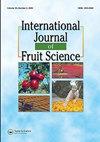Evaluation of Genetic Diversity in Three Diospyros Species, Collected from Different Regions in Iran, Using ISSR and SCoT Molecular Markers
IF 2.4
3区 农林科学
Q2 HORTICULTURE
引用次数: 3
Abstract
ABSTRACT The Diospyros genus contains approximately 400 to 500 species, among which D. kaki is cultivated as the edible persimmon. Knowledge about the genetic diversity of Diospyros genotypes is of high significance for breeding programs. In this research, the genetic diversity of 57 Diospyros genotypes collected from different regions of Iran was evaluated using inter simple sequence repeats (ISSR) and start codon targeted (SCoT) markers. Seven ISSR and 10 SCoT markers produced a total of 42 and 75 fragments with the averages of 6 and 7.5 fragments per primer, respectively. The average polymorphism information content (PIC) for ISSR markers was 0.3 and for SCoT markers was 0.36. The average marker index (MI) for ISSR and SCoT markers were 1.81 and 1.79, respectively. Cluster analysis based on Jaccard’s genetic similarity coefficient and UPGMA method classified 57 Diospyros genotypes into four main groups based on ISSR and SCoT markers. However, the clustering pattern based on the combination of ISSR and SCoT markers data separated the species genotypes better than each marker alone. Accordingly, groups 1 and 2 contained all D. kaki genotypes, both encompassing various subgroups, group 3 included D. lotus and group 4 included D. virginiana genotypes. Genotype distribution visualized with principal coordinate analysis (PCoA) was in accordance with the cluster analysis. Based on our results Iran is a rich source of Diospyrus germplasm, and a combination of ISSR and SCoT markers can be used as an accurate technique for evaluating genetic diversity among the Diospyros genotypes.利用ISSR和SCoT分子标记评价伊朗不同地区三种薯蓣属植物的遗传多样性
Diospyros属植物约有400 ~ 500种,其中D. kaki是作为食用柿子栽培的。了解薯蓣基因型的遗传多样性对育种计划具有重要意义。本研究利用ISSR和起始密码子靶向(SCoT)标记对伊朗不同地区的57个Diospyros基因型的遗传多样性进行了评价。7个ISSR和10个SCoT标记共产生42和75个片段,平均每个引物分别产生6和7.5个片段。ISSR标记的平均多态性信息含量为0.3,SCoT标记的平均多态性信息含量为0.36。ISSR和SCoT的平均标记指数(MI)分别为1.81和1.79。基于Jaccard遗传相似系数和UPGMA方法的聚类分析将57个薯蓣基因型根据ISSR和SCoT标记分为4个主要类群。然而,ISSR和SCoT标记数据结合的聚类模式比单独使用单个标记更好地分离了物种基因型。因此,组1和组2包含所有kaki d基因型,都包含不同的亚群,组3包含莲花d基因型,组4包含弗吉尼亚d基因型。主坐标分析(PCoA)显示的基因型分布符合聚类分析。基于我们的研究结果,伊朗是一个丰富的薯蓣种质资源来源,ISSR和SCoT标记的结合可以作为一种准确的技术来评估薯蓣基因型之间的遗传多样性。
本文章由计算机程序翻译,如有差异,请以英文原文为准。
求助全文
约1分钟内获得全文
求助全文
来源期刊

International Journal of Fruit Science
Agricultural and Biological Sciences-Agronomy and Crop Science
CiteScore
6.40
自引率
0.00%
发文量
64
审稿时长
10 weeks
期刊介绍:
The International Journal of Fruit Science disseminates results of current research that are immediately applicable to the grower, extension agent, and educator in a useful, legitimate, and scientific format. The focus of the journal is on new technologies and innovative approaches to the management and marketing of all types of fruits. It provides practical and fundamental information necessary for the superior growth and quality of fruit crops.
This journal examines fruit growing from a wide range of aspects, including:
-genetics and breeding
-pruning and training
-entomology, plant pathology, and weed science
-physiology and cultural practices
-marketing and economics
-fruit production, harvesting, and postharvest
 求助内容:
求助内容: 应助结果提醒方式:
应助结果提醒方式:


